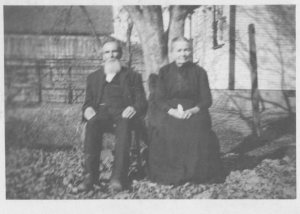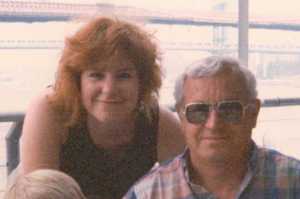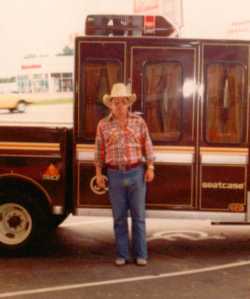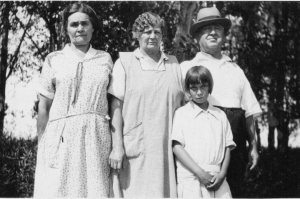You are currently browsing the tag archive for the ‘Otte family’ tag.
Recently I have noticed a rise in discussions on whether or not a woman should keep her maiden name when she gets married. When I was in college in the early 1980’s I had a particularly broad-minded professor who had taken on his wife’s name by hyphenating both together. With gay couples now able to legally marry, the discussion has taken on a new timbre. When two men or two women join together, which name becomes the family name? What names will their children carry? If you’ve grown up with a hyphenated name already, do you just keep adding names? When I was married in the early 1990’s, there was no pressure on me either way. Neither my parents nor my husband gave it a thought. And really my maiden name—Otte—was not one I was overly attached to. For four letters, it was deceivingly difficult. No one ever knows how to pronounce it. (basically “ahh-dee” with a dull “t”) And when in my early twenties I took on a nickname in my professional life, well, “Mickey Otte” sounded strange to the ear—too many “ee’s”. Hyphenating or exchanging my middle name for my maiden name didn’t “sound” any better. So “Herr” was an easy sell…it felt a bit more grounded. A lot of years would go by before I would start to appreciate what it was I had given up. I am only just learning what it is I have taken on with the Herr name. I’m also beginning to understand why some people feel it’s so important to keep particular family names alive. I wonder, if we all knew a bit more about our family names, would we exchange them so easily?
I have shared a good bit of my Otte genealogy in this blog already, and those of you who have read earlier posts know that the family stories I grew up with centered primarily on the Otte family. The stories my father and grandfather shared have influenced me greatly, especially in my fiction writing. Growing up I had never heard of “others” or even came across someone with my same last name that wasn’t a direct relative. I always assumed that when my great-great-grandfather Fredrich Wilhelm Otte arrived in Baltimore in 1834, he was the sole progenitor of all things Otte in America. Of course, I was wrong. By 1837 Fredrich Wilhelm (now known as Will or William) was farming in Ohio. But it appears other people named Otte settled in other parts of the country throughout the years. Are they related? I am still trying to figure that out. It is only in recent years that I’ve actually met some of the non-related Ottes. In my heart-of-hearts I never really believe they are “non-related” because there always appears (to me at least) a certain je ne sais quoi that makes me feel right-at-home with another person who bears the name Otte. If I had to specify what that quality was, it would lie somewhere between reliability, unpretentiousness, and a certain earthy-warmth. Through the years I’ve described my Otte ancestors as salt-of-the-earth.
Sometime in the 1990’s my father started talking about a man he’d become friendly with, a man named John Otte. As I said, the name didn’t appear outside our immediate family so I was intrigued. Even before I met John it seemed obvious there were “family” connections—some genetic qualities that were evident in both men—so much so that it was mutual friends that had brought these two men together. As John recently shared with me, he had first heard of my father in the early 1960’s when he was stationed in California. John’s passion for cars led him to pick up a copy of some sort of Hot Rod magazine that contained an article which featured my father. Of course he zoned in on the Otte name. And he was curious about this man—a man who shared his family name—who was involved in fire safety at a race track in Southern California. John shared the same twin passions—fire safety and fast cars. And eventually, John would become the Fire Chief at Speedway Fire Department (home of the Indianapolis Motor Speedway). Through the years the two men heard of the other in the relatively tight community of the fire services industry. “You must be related” they’d be told, “you have so much in common.” Indeed they did, and once they finally met many years later, they became fast friends. I find it no coincidence that it was John who ended up being the person with my mom and me the moment my dad passed from this world. My dad had been on business in Indianapolis. He was expected to recover from emergency appendicitis surgery. We were all at the hospital. John had come over to watch a car race with my dad while mom & I took a break from the hospital food. It was almost as if my dad had waited for John to enter the room…as suddenly my dad was gone, taken from us by complications of the surgery. John, the practiced Fire Chief was calm and methodical during it all—but it was more than that. My mother and I were in a city where we knew no one, so John instantly became our surrogate family, looking after our well-being and helping us make arrangements. I always believed he was sent there to be with us in our time of need. John and I speak by phone or email on occasion. I pester him with questions, convinced I will be able to one day connect our families through my genealogy research.
A few months ago I was contacted by another non-related Otte through this blog. A man named Fred Otte left me a comment stating something to the effect of “…I look just like your father and I also have a grandfather named Fredrich Wilhelm…” Could it be? Could this be an Otte I was related to outside my immediate family? And while yes, Fred (who also shares the name of my beloved grandfather) shares more than a passing resemblance with both my father and grandfather, it seems we are not directly related. His Fredrich Wilhelm was born years after mine, but I thought perhaps they could be uncle and nephew. Fred quickly dissuaded me of my notion—calling out my (self-admitted) ignorance of German history—by informing me that many little boys were named after German royalty. When I looked it up myself I saw that either a Fredrich Wilhelm, a Fredrich, or a Wilhelm Fredrich served as the King of Prussia from 1713 through the abolition of the monarchy in 1918. So yeah…there could be hundreds of Fredrich Wilhelm Ottes out there, over multiple generations. Fred has been quite gracious about answering all my “family” questions and beyond. It turns out Fred only emigrated from Germany in the early 1950’s. “What was it like,” I asked, “moving to the states after World War II?” An eloquent writer, Fred said he had traded in his apple strudel for apple pie and soccer for the NFL. He was matter-of-fact. He did what he needed to stay under the radar and soon enough no one noticed the German down the block. Fred has shared some of his genealogy which was researched in Germany some 70 years ago by an aunt. I have yet to directly connect our two families together, but my great-great-grandfather was born in the same region where all these other Ottes resided, so I think it’s just a matter of time.
A week ago, I received more mail from Fred. He sent me a copy of a letter he wrote that was published in the December/January 2014 issue of German Life magazine. According to Fred the Ottes have a Familienbund (family organization) in Germany with about 150 members. They have traced the Otte name back to Carsten Otte who was born in 1570 and have even published a family genealogy book (yes! I must get my hands on this!) It turns out the Otte family originally came from Sülze in the Lüneburger Heath from the Rosenhof (Rose farm.) According to Fred the Ottes have been on this farm since the first one married the oldest daughter of a farmer named Rose in 1660. The Otte name is common in the area of Sülze even today. What Fred stated next was a pleasant surpise, as “Sülze” he says is German dialect for saltwater. And there was a time when production of salt in this area was a major industry with the Sülze salt works first mentioned in 1381. Fred believes these Otte ancestors supported the salt manufacturing by cutting peat and working in the boiling houses. Several of them were “Salzfahrers” or salesmen who traveled the countryside with a wagon full of salt.
Yup. My American Otte relatives were real “salt-of-the-earth” types. If I can indeed connect them to Fred’s German Ottes, it appears my description was more apt then I ever could have imagined.
Today is Father’s Day. It’s been more than six years since my father, Dick Otte, passed away unexpectedly at the age of 69, on Sunday, April 30, 2006. I can’t say I dislike Father’s Day, but it’s still not easy. What complicates things further is that yesterday would have been my father’s birthday. As a young girl, this time of year was always a time of great anticipation: the last day of school, Flag Day, my father’s birthday, and Father’s Day always fell within a few days of each other. And of course, these events also meant that vacation was near…a new adventure was about to begin.
I hesitated as to whether I should be writing about my father in this genealogical blog, wondering if it really fit into my original intent of “communing with the ancestors”… but, as he is the person responsible for half of my ancestry, I decided I could be self-indulgent.
Last night I attended a production of Annie, because my dear friend Jenny was playing the part of Miss Hannigan. She was a fabulously funny, drunk, bitch…which was all the more enjoyable because her true nature—a generous, loving, tea-totaler—is so extremely different from the character she portrayed. Having seen Annie on more occasions then I can even recall, I was struck last night by its message of a father’s love. Perhaps because my father was on my mind…and certainly heightened by the fact that the adult male characters (none of whom were professional actors) were played by the fathers of the young girls in the cast… I couldn’t help but think about those girls on the stage…and how, years from now, each one will remember her father on that night. And of course, Daddy Warbucks was ready to do anything for Annie, even if it meant losing her.
Even in death, my father continues to both challenge me and provide me the insight to meet those challenges. One of the reasons I actually started my genealogical journey (and this blog) was my father…as it germinated from the research I started doing for a book I plan to write, the basis of which stems from my father’s childhood stories. I don’t find it a coincidence that my mother suddenly discovered a previously unknown cache of family photos and notes (left behind by my father) now that I am writing this blog. Those of you who regularly follow my posts are aware of the information contained in those particular photos because it opened doors and led to my “Es ist Gemütlich” post.
And when my father died and we were planning his memorial service, I would face one of the biggest challenges in my life. My father had many, many friends and acquaintances; including a fair number who had been part of his life for more years than I had. In the days before and after his service, my father was honored as a “Pioneer” for his work in rescue tools and safety in both the fire and motor sports industries; Pennsylvania Congressman Curt Weldon had a flag flown over the Capitol Building in Washington DC in his honor and Deputy US Fire Administrator Charlie Dickinson (of the Department of Homeland Security) wrote a heartful tribute. These were all lovely and much appreciated gestures. But who would talk about my father as the family man? Could I really stand up in front of a hundred or so people and eulogize my father? The answer was yes. And in the end, it was a gift to stand witness to the man who had given so much to so many.
Following is the Eulogy I gave on Wednesday, May 17, 2006 at a service held in the Red Clay Room of Kennett Fire Company #1, on Dalmatian Street in Kennett Square, Pennsylvania (with photos added in):
In the hours after my father died, my mother and I found ourselves gingerly rummaging through my father’s belongings—those few things he had taken along with him to the FDIC conference in Indianapolis [the world’s largest firefighter training conference, an event he had attended every year]. I don’t think we were searching for anything in particular, but what we found said quite a lot about who he was. His wallet contained a $2 bill. The same one carried by his father on the day he was killed in a car accident. [Was this a reminder of his father? A good luck token?] His date book contained, along with detailed notations of every fire conference for the year 2006, some vintage photos—including one of my sister at age three riding a rocking horse. We found his well-used pocket-sized road atlas featuring a center-fold of the United States. He also carried a small notebook full of collected notations—little affirmations and poems that caught his fancy. There were several that, viewed in retrospect, nicely describe his philosophy on life:
“People who build walls and not bridges will be lonely”
“Imagination is more important than knowledge”
“You may be on the right track, but don’t just sit there or you’ll be run over”
“Progress in life is not measured by security, but by growth; and growth means taking occasional risks, you’ll never get anywhere interesting by always doing the safe thing.”

Is there any question that my dad enjoyed a vivid imagination? Here he is at age 12 with his latest creation
There were a few others that should have been in his notebook- I’d like to propose four affirmations to add to his collection to further illustrate his particular philosophy on life [which will also provide some clarity as to why he chose to fill his pockets with the items I mentioned]:
1. Marry Your Best Friend

I was lucky enough to marry my best friend too. Here we are with my mom and dad at Thanksgiving in 1991, a few months before we were married.
My father seemed to understand at a relatively early age that having the perfect partner in crime was a really good start to an adventure. When he met my mother, there was no question—she was the one he wanted to marry. They left Nebraska and spent the next 49 years criss-crossing the country.
As children, it seemed to my sister and me that our father was always in the center of the action…working on fire suppression systems for the rockets traveling to the moon, rescuing race car drivers in the heat of a crash, working on the set of our favorite television show—Emergency—teaching Randolph Mantooth how to use the Jaws of Life. Even in recent years—making sure needed rescue equipment got to the World Trade Center and the Pentagon on 9-11.

My dad (right) teaching actor Randolph Mantooth (middle) how to use the Jaws of Life, on set of Emergeny in the early 1970’s
Where our father was magical, our mother was practical… for no matter where my father roamed or what state he moved the family… our mother created our home—our soft place to fall. She created the space where we were a family—just the four of us. And even now, with the addition of one grandson and one son-in-law—home for all of us is where our mother is… even if it is in a town we’ve never been to before.

The nuclear family c. 1965… mom, dad, sister Cindy and me (not yet one year old)….I love this picture because I have no memory of my dad wearing a suit when I was a child…
What I witnessed through the years was a deep respect between my parents. They were two complete individuals on their own, each with very different interests and neither needing the other for survival. But at the end of the day, both enjoyed nothing more than each other’s company. They shared many adventures together- and they remained each other’s best friend.
My mother said that she knew my dad was the guy for her on one of their first dates. My dad took her to the movies to see Old Yeller… and he cried. This brings us to our second affirmation:
- Don’t be afraid to show your sentimental side
My father didn’t just cry when a dog died… he would cry during a Hallmark commercial… the first, second, and third time he watched it.
One of the best illustrations of this sentimentality was his love of parades. He loved a parade… any parade… once he even took my sister and me to see some low-riders parading their cars in downtown LA. A holiday wasn’t complete without going to a parade… the Hollywood Christmas Parade, the Rose parade, the Chinese New Year parade in San Francisco… several years back we all went to the historic Fourth of July parade in Bristol, Rhode Island… one particular family favorite was the Fourth of July parade we attended in Lynchburg Tennessee. There were so many townspeople in the parade, there were very few people left to watch. We all loved that parade. And we can’t forget one of his perennial favorites… the Main Street Electric Parade at Disneyland.

A holiday wasn’t a holiday without a parade…here I am (in silly hat) with my dad in Bristol RI on the Fourth of July c. 1997… he especially loved all the vintage fire trucks
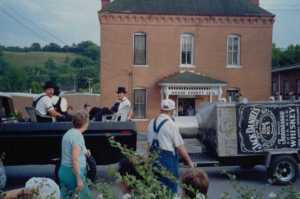
A Fourth of July parade in Lynchburg TN in the mid-1980’s…an unexpected event that became a favorite family memory…
There was one bit of Disney-sentimental pop he loved even more than their parades however… at the end of the day… we always had one last stop before heading to the car- we would go to the theater in the round to see “America the Beautiful.” To this day, my sister and I have this movie memorized… flying in a plane over the Grand Canyon, traveling by wagon through a covered bridge. We watched those images… the crowd sang along to America the Beautiful and inevitably, my father had a tear in his eye… because there’s nothing he loved more than his own country.
Which brings me to our third affirmation:
- Get in the car and drive!
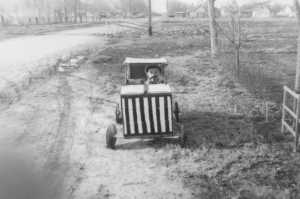
My father’s love of cars started at an early age. Here he is with what is likely his first soapbox derby racer. He would build several soapbox cars, eventually representing the state of Nebraska in the Derby Championships in Akron, Ohio in 1951.
My father would drive anywhere… at any time. Period. He loved to drive and he loved to explore. It was rarely about the destination… it was really all about the journey. I swear he didn’t care if he even got out of the car once we got to where we were going.
Family vacations always involved driving someplace- as a family we have driven cross-country more times than any of us can remember. But each trip held some great new discovery. My father always knew where to go in any town… exactly what mile-marker the gas station was… where there would be none… and which motels to stop at. I say motel… because he loved a good motel… one where you could drive your car right up to your front door… it took him years to give in and stop at a place where you had to actually walk through a lobby to get to your room.
In the state of Washington I remember the smell of freshly cut timber and seeing a color green I never knew existed, the absolute beauty of the high-desert in New Mexico covered by a dusting of snow, watching the Taos Indians dance their sacred bear dance on Christmas day, witnessing the infamous duck-crossing at the Peabody Hotel in Memphis, touring the Ryman Auditorium in Nashville, the entire year of 1976 when dad decided we would visit every historic site from Monticello and Mount Vernon up through the Old North Church in Boston, … really, anytime in the car with my father was a happy time… which leads us to our fourth and final affirmation…
- Live your passion- (do what makes you happy)
My father never worked a day in his life. Rather, he figured out how to combine the things he loved… traveling cross-country, with his family in tow, driving to a race track where he’d soon be providing fire safety services- might just have been his definition of perfection. All things he loved in one place, at one time.

“On the job” in the early 1960’s at Riverside Raceway, ready to put out a fire or rescue an injured driver

Dad at work in the mid-1970’s…training firemen in the art of rescue tools… he loved teaching…something he did throughout his life

Dad at work in the 1980’s… a bit of fun during a convention…everyone waited to see what he was up to next…
Throughout my life I’d go to my dad and say “Dad, I need some advice- what should I do?” He’d say- “well- you need to get out your paper, make two columns, then list all the pros in one column and all the cons in the other.”
I would dutifully make my columns… and still not know what to do…“But dad,” I’d plead… “what should I do?”
“Do what makes you happy,” he’d always say.
“But what if I don’t know what will make me happy?”
“Then you’d better go figure it out. If you don’t know, how is anyone else going to know?”
It was as simple as that. I was the key to my own happiness. With that knowledge he gave me the greatest gift anyone could. He wouldn’t give me the answers. He challenged me-he challenged me to figure out what makes me happy… he taught me to know myself, to trust myself, and to be myself. It is only then that you can truly live your passion.
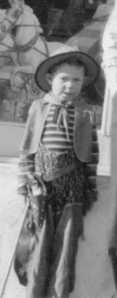
My dad the cowboy c. 1940… a persona he adopted at an early age…he was most himself in a pair of broken in cowboy boots
The truth of the matter is, my father was a relatively uncomplicated man with simple pleasures. Give him a box of popcorn, a comfortable bench on a warm afternoon… and he was content- he was content just to be in the moment and watch the people pass by.
Another of the poems found in my father’s little notebook was one by Ralph Waldo Emerson:
“To leave the world a bit better, whether by a healthy child, a garden patch, or a redeemed social condition: to know even one life has breathed easier because you have lived. This is to have succeeded.”
I couldn’t have said it better.
NOTE: for more about the professional side of my father’s story please visit http://wp.me/p2OXia-28
I was dreaming in German last night… for the second night in a row. The problem with that is, well, I really don’t understand German. I actually studied the language in school…two years in junior high, two years in high school and a painful semester freshman year of college. I suppose it says more about how Americans are taught languages and less about my intelligence…regardless, it’s silly for me to say “ich verstehe nicht”… but who was I actually going to converse with in German?
One of the reasons I chose to study German, instead of French or Spanish, was actually my family heritage…I’m not sure exactly why, but it had something to do with honoring my ancestry. I suppose that was as good a reason as any. I remember consulting my parents and they thought it was a good idea at the time. And now I find I really do want to learn (or relearn) the language. I’ve gone so far as to “google” available classes in my city. I’ve scoped out the Germany Society website to see what they offer. And…that’s as far as I’ve gotten.
And now this… I’m starting to dream in a language I don’t understand. It’s those voices in my head again. Only now we have a language barrier. Go figure.
Es ist gemütlich… I woke up sometime last night with that thought in my head. In the haze of sleep I remember thinking…you need to look up that word in the morning. Germütlich. It’s actually not unusual for me to wake up in the middle of the night to remind myself to follow through with whatever it is I happen to be dreaming of. Sometimes I think my waking hours are in service to the people, places, and events that populate my sleeping time. So, this morning I dug out my German translation dictionary and found that es ist gemütlich might mean something like… it is comfortable, cozy or pleasant. If I had heard “sie ist gemütlich” it would mean something more like she is friendly, cheerful or easy going.
Wikitionary tells me that gemütlich derives from Gemütlichkeit… “a word that describes an environment or state of mind that conduces a cheerful mood and peace of mind, with connotation of a notion of belonging and social acceptance, of being cozy and unhurried.” Okay…so it appears I was having a peaceful sort of experience in the middle of the night.

Which one should I listen to first? Ella Miller, Dora Otte, Henry Otte, Eliza Otte (mother), Marie Otte, Lizzie Kuenning, ?, Wilbur Kuenning, John Doench, ? Miller, Henry? Miller, Mary Doench, Christ Otte, Katie Kendig, Harold Miller
Of course this notion of “belonging” makes a lot of sense in relation to all this digging around I’ve been doing into my ancestral roots. In past posts I’ve mentioned the fact that once I metaphorically opened the door to this process, I started to receive a tsunami of information. It’s a bit overwhelming really. I am starting to feel like Whoopi Goldberg’s character in Ghost…when she’s sitting at the table about to channel the spirits and there’s a long line of dead relatives waiting to speak… and suddenly the spirits get frustrated waiting for their turn and they all attempt to inhabit Whoopi simultaneously? Yes. That’s about right. So today I am going to attempt to embrace the gemütlichkeit… and spend some unhurried time with my German relatives…
These German ancestors basically break down into two sorts…those who arrived in the British colonies prior to the American Revolution and those who arrived in the early decades of the 19th century. I’m told that the earliest German immigrants were searching for religious freedom. It should have come as no surprise then that these ancestors were attracted to William Penn’s promise of religious tolerance. Yet I am still taken aback each time I discover a 5x or 6x German grandparent living in Pennsylvania (my current home state) prior to the American Revolution. Along with the Zartman family I’ve previously mentioned, there were families named Fisher & Fischer, Schieff (Scheaff), Lefler (Lofler), Pflueger, Trinkel, Denger, Wambold, Hauser, Ehro, and Reitenauer (Ridenour). Some claim the Reitenauers to be French, but they were likely from the Baden-Württemberg area that had permeable borders with France. These particular ancestors did not appear to be attracted to city life in Philadelphia. While several lived out their lives in the Germantown section outside of downtown area, most moved westward settling in the counties of Berks and Lancaster and further out to the counties surrounding the Susquehanna River. The first Federal Census conducted in 1790 showed that a full third of Pennsylvania’s residents were German. Many of those Germans continued to spread westward. A good number of my own ancestors ended up in Ohio and were among the earliest settlers of that state.
The second wave of my German ancestors arrived in America between the approximate years of 1833 and 1855. Many Germans immigrated at this time—having received word from those friends and family already established here—that they could acquire cheap land with relative ease. This was a time of large scale immigration, with early immigration averaging at about 10,000 Germans a year to the peak in 1854 of approximately 220,000 German immigrants. Those who arrived in later years (around 1860) were offered US citizenship if they volunteered to fight in the American Civil War.
One thing I find fascinating is how the Germans stayed so “German”… they continually married other Germans and mostly lived in German communities. On my paternal side, I can’t find anything but Germans…my great grandmother was born in Canada, but that’s only because her German family (named Weidenhammer) immigrated there before they headed to the United States. It took until 1935 for the first “break” in the family to occur—when my grandmother Evelyn Marie Kaasch eloped with my grandfather Clifford McGuffin, she was the first person to marry a non-German. No wonder my great-grandmother Julia Bott Kaasch was so upset. As active readers of this blog already know, Julia descended from the Zartman family, who were part of the pre-Revolution group of German immigrants. The first wave Germans in my family continued to marry other first wavers up until my great-great grandmother Martha Zartman. She married Gottlieb Bott, whose family had only arrived in around 1845…a relative late-comer. Martha’s daughter Julia married Archie Kaasch, whose grandfather arrived on the scene in 1853. Even though they married second-wavers, they still managed to marry men who came from the same regions (or states) of Germany from which their ancestors had emigrated. I don’t think this is coincidence. Julie Bott Kaasch, the seventh generation born in America, even attended German school as a child (in the 1890’s).
I stated that my German ancestors arrived in two waves…I should say that 98% of them arrived in the first two waves… my paternal grandmother’s father and grandparents (the Schank Family) did not arrive until about 1883. They were part of a wider immigration movement in the 1880’s that was driven by the increased availability of steamships and ocean liners. This last wave of European migration would be the impetus for the creation of Ellis Island which opened its doors in 1892. When my parents visited Ellis Island many years ago, they came away broken-hearted that they could find no information about any of their ancestors. What they didn’t realize at the time is that all of their relatives had arrived well before Ellis Island had even been created.
When my father married my mother, he was the first on my direct paternal side to marry a woman who wasn’t 100% German. My mother’s maternal German roots run deep, but the paternal (McGuffin) half of her carries Scotch, Irish, English, Dutch, and French blood (and it appears not a drop of German). While I’ve grown up self-identifying as being of German descendent, it’s been my mother’s paternal McGuffin roots that have held the majority of my interest these past few months…as they were previously unknown to me AND fascinating to boot.
Today I’ve decided it’s time for me to delve a bit deeper into the Otte family. This is my maiden name…the name I carried for 27 years. I thought I knew the story of the Otte family. As it turns out there was a bit more to discover. My mother recently came across a large envelope that she hadn’t realized existed. We think perhaps it was given to my father by his father Fred Otte. Back in the ‘80’s my father had an interest in tracing his roots and grandpa Fred had given him some information he’d obtained from one of his Ohio cousins. My father probably put this envelope of information and photos in a drawer for that magical time he planned to look into it all. With my grandfather and father no longer here I was overjoyed to be handed this envelope. My grandfather was a good storyteller and lucky for me, he left some good notes and photos with detailed descriptions.
The Ottes were part of that second wave of German immigrants…the ones that came to America looking for land. Growing up on the extreme West and then East coasts, my maiden name was quite rare and NO-body could figure out how to pronounce it… Oat, Ohtay, Ahht, Audi…for the record it’s “Ahh-dee” although some might pronounce a bit more of a “t” than a “d”… We used to joke in my immediate family that if you came across another Otte you’d surely be related…because we thought there were about twenty in America. Turns out we had it all wrong. I’m told if you live in a place like Ohio and Indiana there are thousands of them…and people actually know how to pronounce the name when they see it. Imagine that! It appears there were many people with the name Otte that arrived from Germany at this time in search of land. They all had the same idea and Ohio seemed to be a good place to go when you were looking for your plot of paradise in the 1830’s. My particular branch arrived in Baltimore Maryland in 1834. My 3x great-grandfather Friedrich Wilhelm Otte (aka William) arrived at the age of 23. It appears he met his wife in Baltimore, Anna Marie Elizabeth Buddemeier, as records show they married and settled in Baltimore in 1836. I believe they both came from the Nordrhein-Westfalen area of Germany. I have yet to determine when Anna arrived and whether she came with her parents or other siblings. But by 1837 the couple left Maryland and relocated to Ohio. It wasn’t until 1854 that they purchased their own 80 acre farm 3 miles west of New Bremen Ohio. Anna gave birth to 7 or 8 children…my 2x-great grandfather, Johann Wilhelm (William) Otte, was their third child and first son. He was born in Mercer County Ohio in 1843. In 1863 this (second) William would marry Anna Marie Elizabeth (Elisa) Sollman. Like William, Elisa’s parents also arrived in Baltimore (in 1833), but her family came from Osnabruck Germany. Elisa was born in Indiana, but eventually her family too settled in the New Bremen area of Ohio.

Anna Marie Elizabeth (Elisa) Sollman Otte b.1839 in Brookville, Indiana and d.1927 in New Bremen, Ohio
The 1880 Federal Census shows William and Elisa living and farming alongside William (Sr.) and Anna. I was told that in 1900 they purchased their own 10.5 acre farm. Elisa gave birth to 9 children during this time period, the last child, a boy died at birth. Elisa & William also raised a boy Fred who came to live with them after his parents had died, and later when they were in their seventies, they took in a little girl named Dora whose mother was a relative of Elisa’s.
William and Elisa’s children were: Mary (b.1863), Katie (b. 1865), Will (b. 1868), Christ (b. 1870), Lizzie (b. 1872), Henry (b. 1874), Fred (b. 1876), and Carrie (b. 1877). Henry was my great-grandfather and the man previously chronicled in “Homesteaders, Hometowns & Final Resting Places” (see 2-17-12 post). I remember my grandpa Fred mentioning his various aunts and uncles through the years…and his Ohio cousins, but it wasn’t until this week that I really gave them much thought… until I took time and dissected the information and photographs contained in that envelope my mother delivered.
The first photo that captured my imagination… captured my heart really…was one of sister Katie (age 62 and widow of Walter Kendig), sister Mary (age 64) and her husband John Doench (age 60, a bricklayer from Dayton Ohio). According to my grandpa Fred the picture was taken in 1926/27, when the siblings were visiting their brother Will who had cancer. Will was a farmer who also had a ranch about 30 miles northeast of Scottsbluff, Nebraska. They took John up to the ranch as he’d never been out of Ohio prior to this trip…out there in the middle of nowhere John said he thought he had come to the end of the world…and if it wasn’t, you could certainly see it from there.

c 1927: John Doench looking out at “the end of the world” with his sister-in-law Katie (l) and his wife Mary (r)
The second photo features their niece Wilma at about age 10. Even at that age she looks like she can take care of herself…but I think about her knowing her father would die a short time after the photo was taken. She would go on to have a ranch of her own, as she married a man named Irvin Petsch who’s family were ranchers in Wyoming. They purchased the Y6 cattle ranch in Meriden Wyoming which grew to over 40,000 acres.
These sisters fascinate me. Mary was 34 years old when she married her husband John, Katie was 36 when she married Walter Kendig, a barber 4 years her junior. Sister Lizzie was 28 when she married Ed Kuenning. Ed appears to have been a farmer. Lizzie would have one son a year after their marriage, but would become a widow within a few short years. Neither Mary nor Katie had children. After Katie & Walter married they lived with Lizzie and her son Wilbur on what appears to be Lizzie’s farm, as the 1910 census lists her as “head” of house and a farmer. Brother-in-law Walter Kendig is listed as a barber. Katie’s husband would die by 1916, after 14 years of marriage.
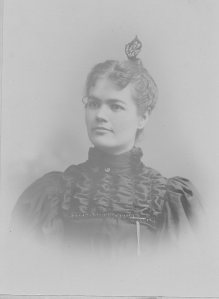
Katie Otte as a teenager c. 1880’s (While my grandpa Fred had this labeled as his Aunt Katie, cousin Lucille thinks its really sister Lizzie- they look a lot alike…it’s hard to tell!)
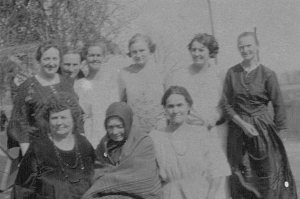
Mother Elisa with her daughters and daughter-in-laws: Ella Miller (sister-in-law of son Henry), Dora Otte (wife of son Christ) Lizzie Kuenning, Marie Otte, Ada Kuenning, ?, Mary Doench, Elisa Otte, Katie Kendig
All of these women appear to have lived their lives on their own terms….with independence and their own homes and jobs. Katie worked for many years as a cook for the NCR company (National Cash Register) that was based in Dayton. Before Lizzie turned to farming after marriage she was listed on an earlier federal census as a dressmaker. Unfortunately it appears the same cannot be said for their youngest sister Carrie. I was curious as to why I never found Carrie included in the pictures at all these family gatherings. She too lived with her sister Lizzie for a short time, but tragically ended up in the Dayton State Hospital (for the Insane). The history of the hospital can be found online…and it appears to be one of those Victorian era locations that were once billed as “ a retreat” that we now understand could be quite torturous. I have yet to discover what led young Carrie to be institutionalized in such a place. She would spend 18 years at the hospital and die at the age of 40 of heart failure. It makes you wonder if she didn’t just die of a broken heart.
The brothers also appear to live their lives in an independent fashion…with three of the four heading out to Nebraska to acquire their own land through homesteading. Will and Henry would make a life in Nebraska, while brother Christ would eventually return to Ohio after several years. Youngest brother Fred seems to stick close to home. He married, but only stayed with his wife a short time before they were divorced.
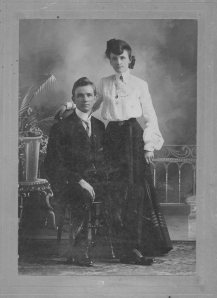
c 1905…Fred Otte was married to Grace for a short period of time, this photo was taken in Dayton Ohio
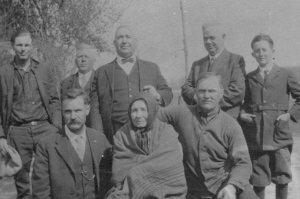
Mother Elisa with some of the Otte men: Wilbur Kuenning (Lizzie’s son), ? Miller, John Doench (Mary’s husband), Henry? Miller, Harold Miller, Henry Otte, Eliza, Christ Otte

The Otte brothers returned to Ohio for visits. This is c. 1920 at the New Bremen home of sister Lizzie Kuenning with their mother Elisa. Also pictured (back row) brother Henry Otte, sister Katie Kendig, nephew Wilbur Kuenning,, and brother Will Otte. Front row with their grandma is Ray & Fred Otte (Henry’s sons). I love they way Fred (my grandpa) is mimicking his uncle Will’s stance.
And this is where I am going to end my tale of the children of William & Elisa Otte for today…as there are more stories to come. What I will tell you is that inside that envelope I found a letter written to my grandfather and grandmother (Fred & Dolly). It was from the early 1980’a and was an exchange discussing some family pictures that Fred had sent to his cousin Marie’s daughter, a woman named Lucille Francis. When I saw that name a light bulb went on in my head, I had seen that name before (quite a lot in the last few days as it turns out)…Lucille Francis…attached to all this wonderful family information on a website called Find-A-Grave. She literally knows where all the bodies are buried. With a small bit of sleuthing I found Lucille’s email address and sent her a message…within hours she sent me a reply…and we’ve only just gotten started on our own exchange…two days in. I’m not quite sure what our official relationship is, her mother and my grandfather were cousins…so it makes us some sort of cousins, several times removed? Good enough.
I will give you a little tidbit of what she has sent my way… and save more stories for another day.
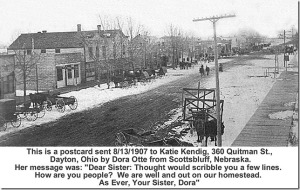
Dora Otte sent this postcard home to her sister-in-law Katie Kendig c. 1907. I love the sense of Dora’s spirit you get from what she writes. (Thanks to Dora’s granddaughter Lucille Francis for sharing this)
I will say one last thing…getting to know these great-great aunts and uncles over these past few days has certainly made me feel a bit more gemutlichkeit about my maiden name. It was a name I gave up easily on the day I got married. I feel much more connected to it now. (Oh…and a special shout out to my own sister…who knew our Otte great-aunts were so kick-ass?)

